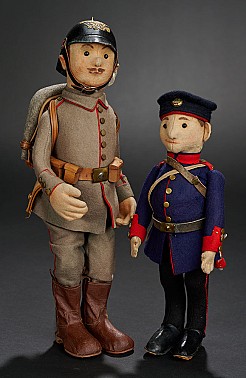Very Important French Bisque Art Character by Albert Marque in Original Costume
Lot #17
22" (56 cm.) Bisque socket head with unique four-part mold, elongated throat, full lower cheeks, defined rounded chin tip, blue glass eyes, painted curly lashes with darker lashes at bottom eye rim, brushstroked and feathered brows, accented eye corners, high forehead with well-impressed temples, distinctively-shaped nose with rounded tip, closed mouth with shaded and accented lips, distinctively-shaped ears, pierced ear holes, original brunette mohair wig and pate, uniquely designed composition body whose torso tapers from narrow shoulders to broad hips, undefined waist, elongated composition upper arms, bisque forearms with attached bisque ball-joints at the elbows, separately-sculpted fingers, wide upper thighs, elongated lower legs with shapely calves, slender ankles, elongated feet. Condition: generally excellent, perfect bisque of head and arms, original body. Marks: A. Marque (incised signature) 23 (red ink number on head). Ivanoff (ink script on foot). Comments: France, circa 1916, designed by noted Parisian sculptor Albert Marque, as part of a movement to re-invigorate the French doll industry; the movement involved sculptors, porcelain firms, fashion designers and virtually the entire art community including the blossoming Parisian Ballets Russe. Albert Marque, the noted French sculptor was thus commissioned to design a doll that reflected the actual expressions and moods of childhood. Even the body was uniquely designed for the doll by fellow artist, Aristodeme Botta, who aimed to create a model that "combined the strength and grace typical of that age", that is, an older child. The artistic doll of Albert Marque was first presented at an exclusive exhibition at the fashion boutique of Parisian art patron, Margaine-Lacroix. It is believed that only 100 models of the Marque doll were created, of which this is #23 in that series. Value Points: extremely rare doll, wearing its original Russian-themed costume likely inspired by the then-popular Orientalism movement; Russian embroiderers were directly employed by the Paris fashion houses, and no doubt had a broader influence on costume. The "Ivanoff" mark on the foot may refer to the 19th century Russian ballet dancer and choreographer of who was still revered; it is possible that this is a copy of Ivanoff's own costume design. Ex-Collection Dina Vierney, featured on the cover of her landmark 1996 auction. The doll has been preserved in one private collection since that time.





































































































































































































































































































































































































































